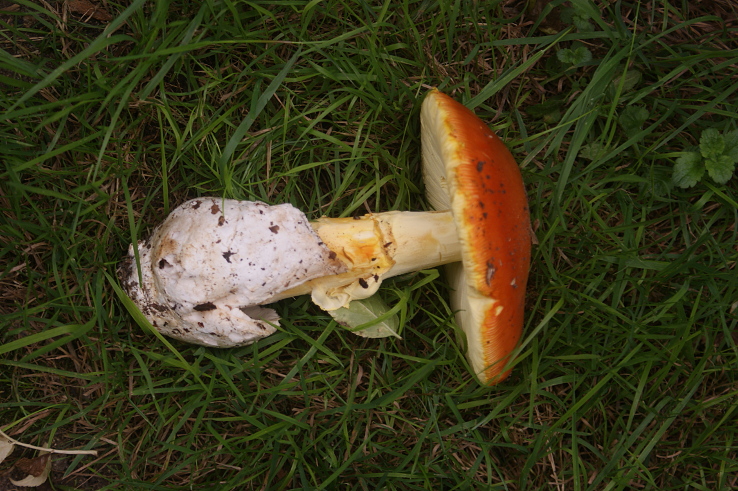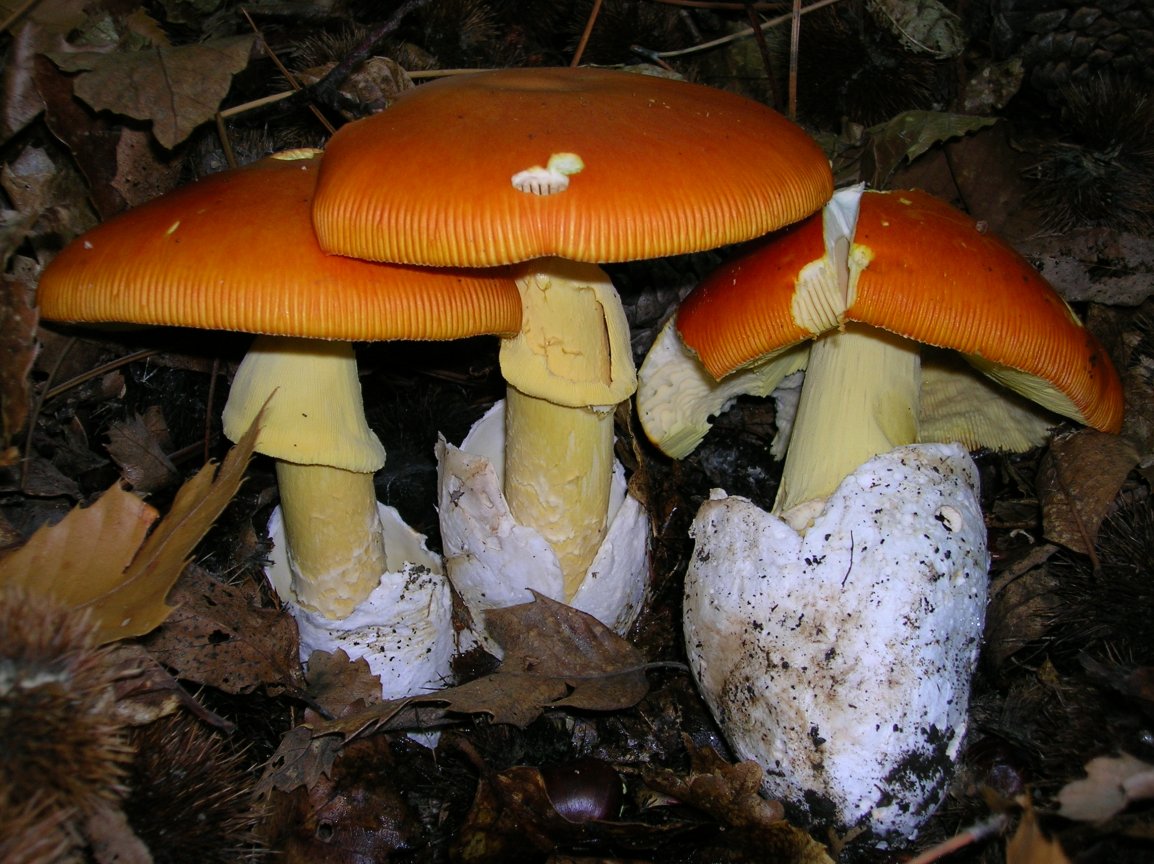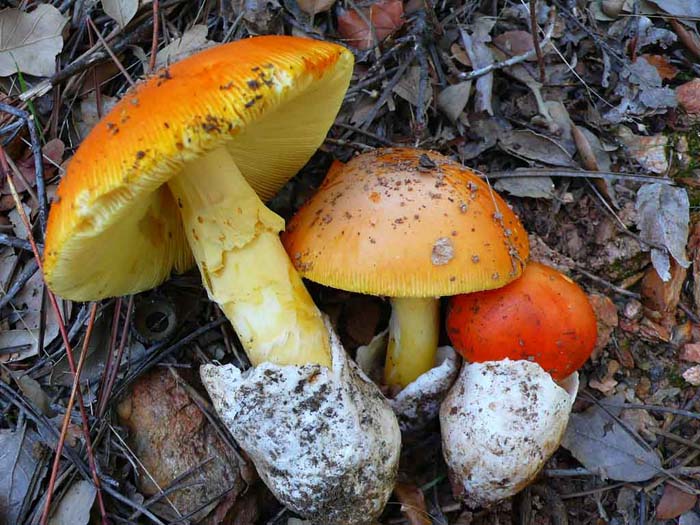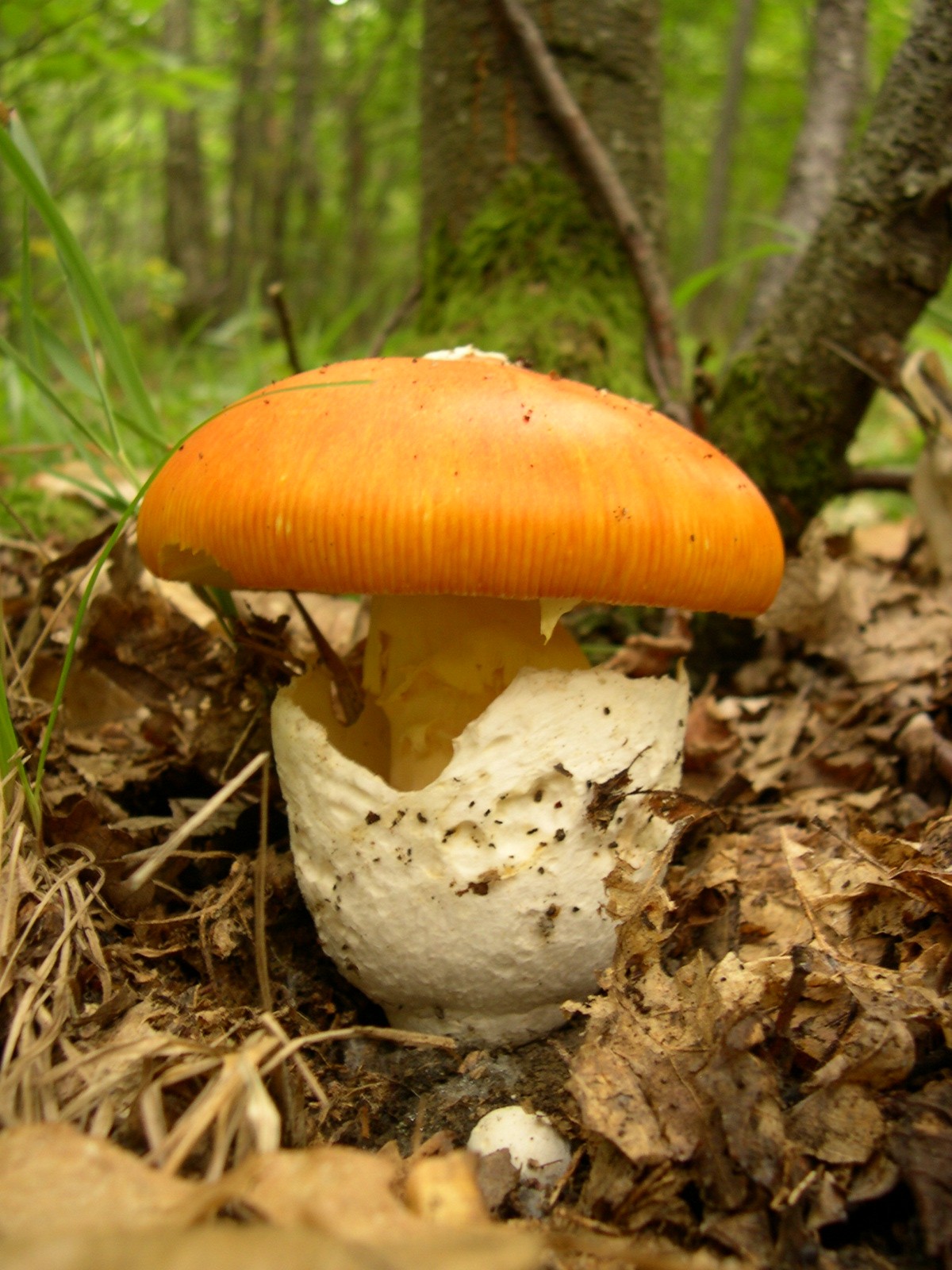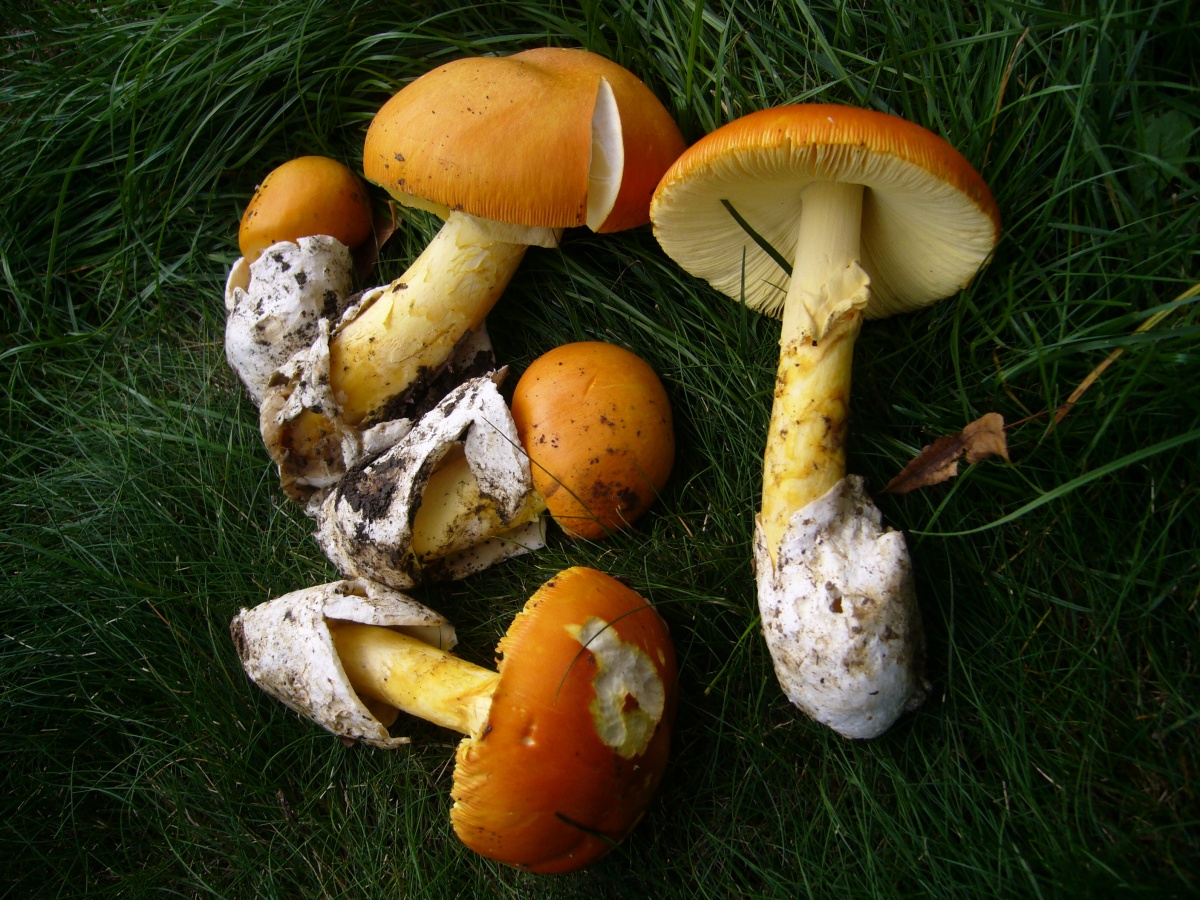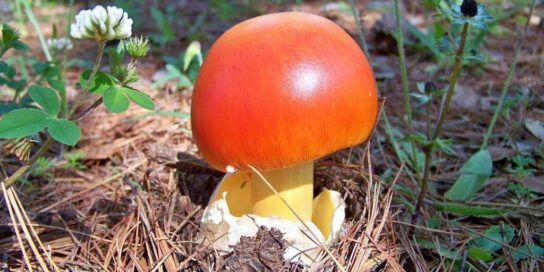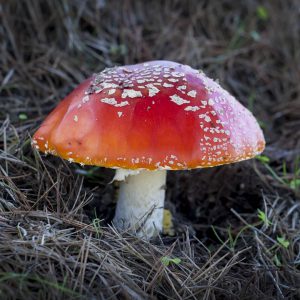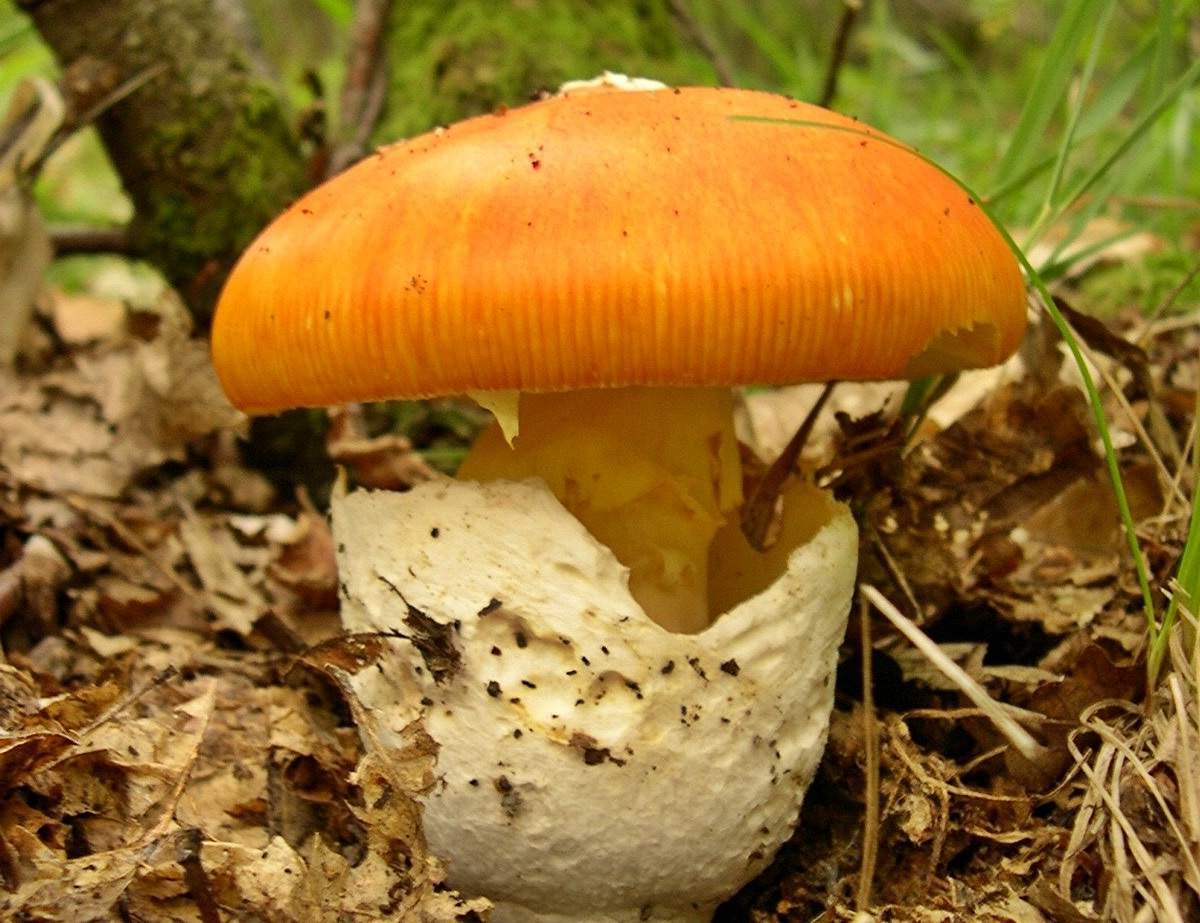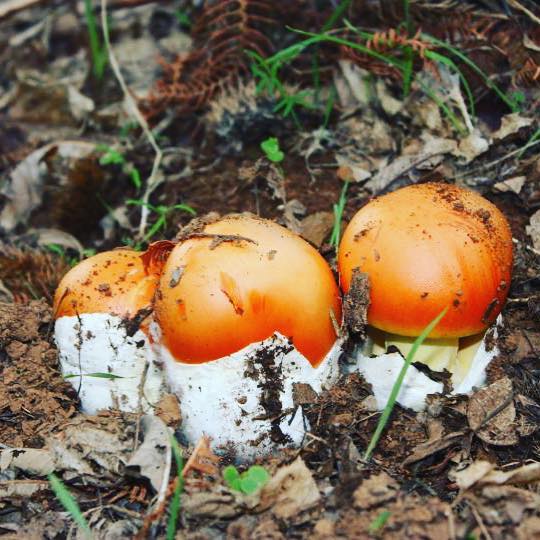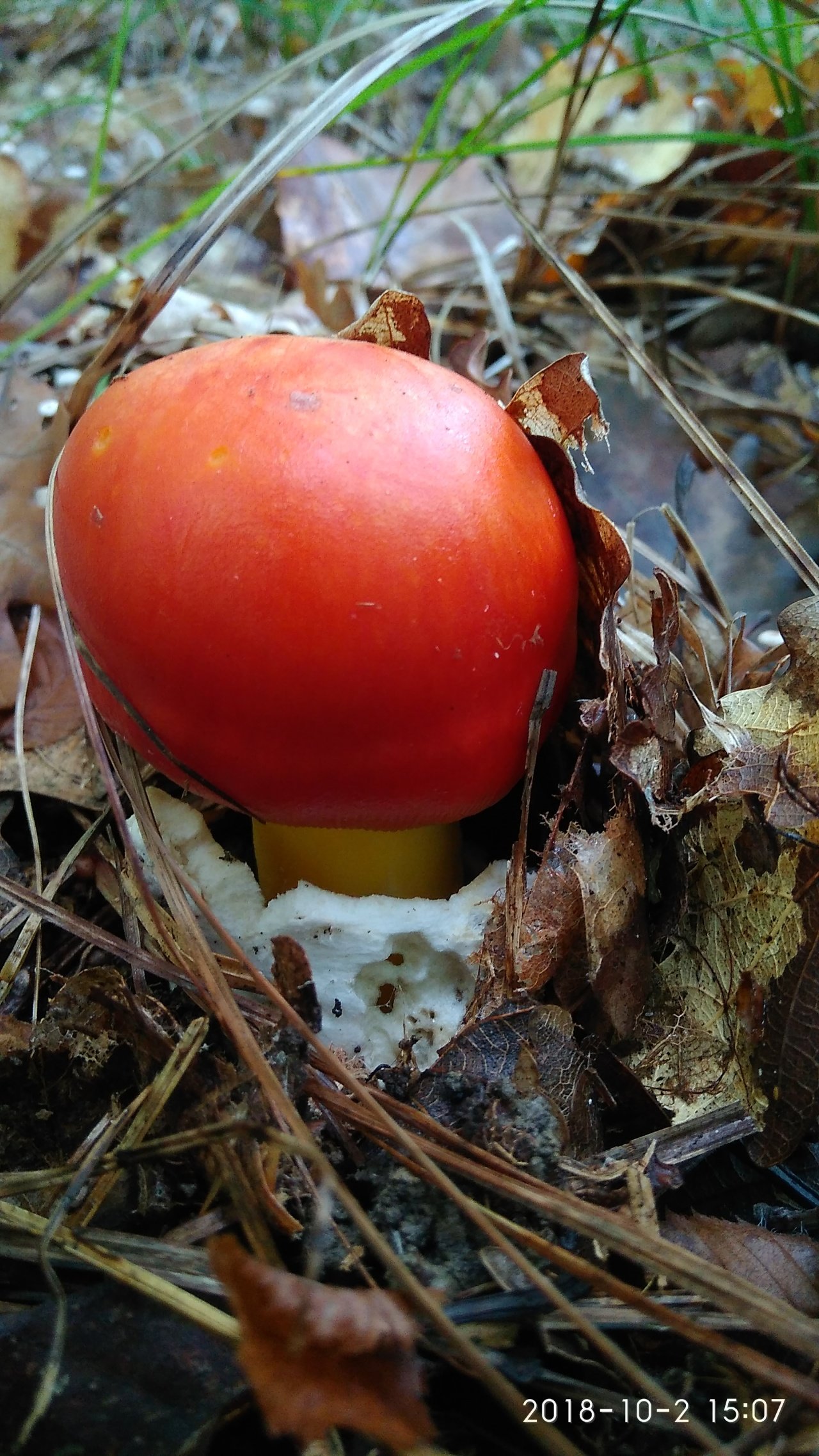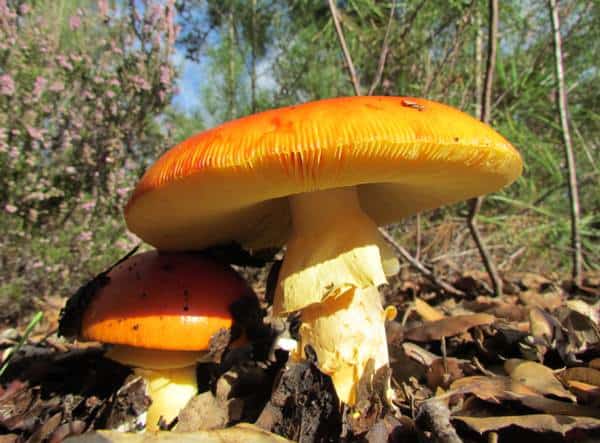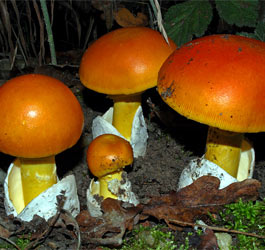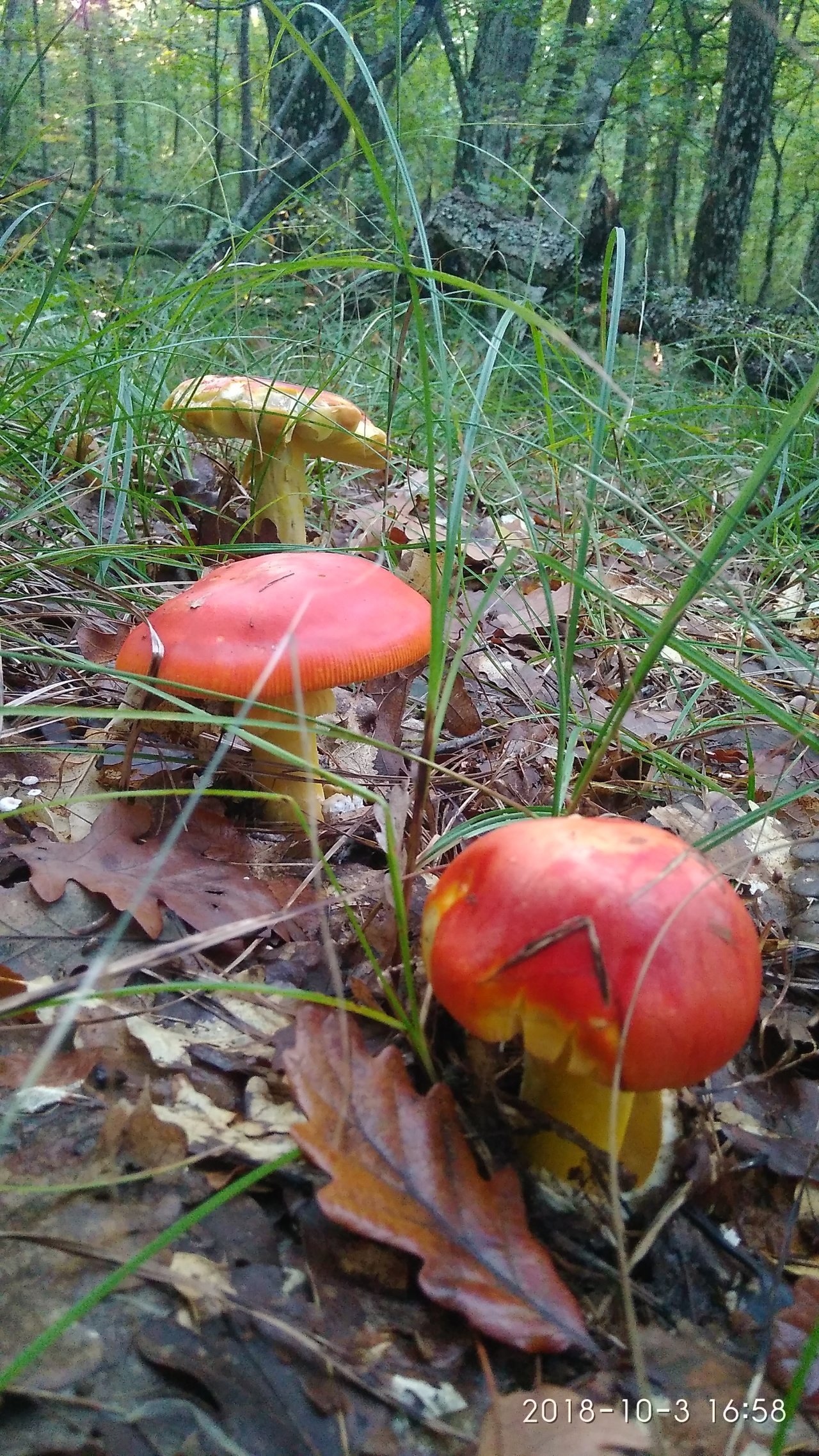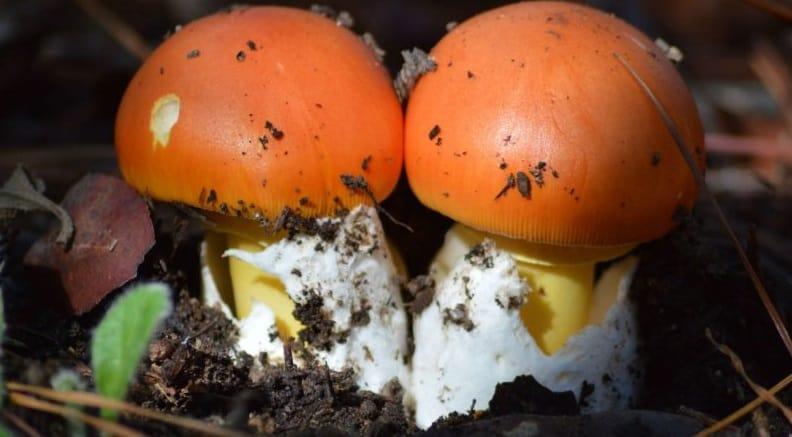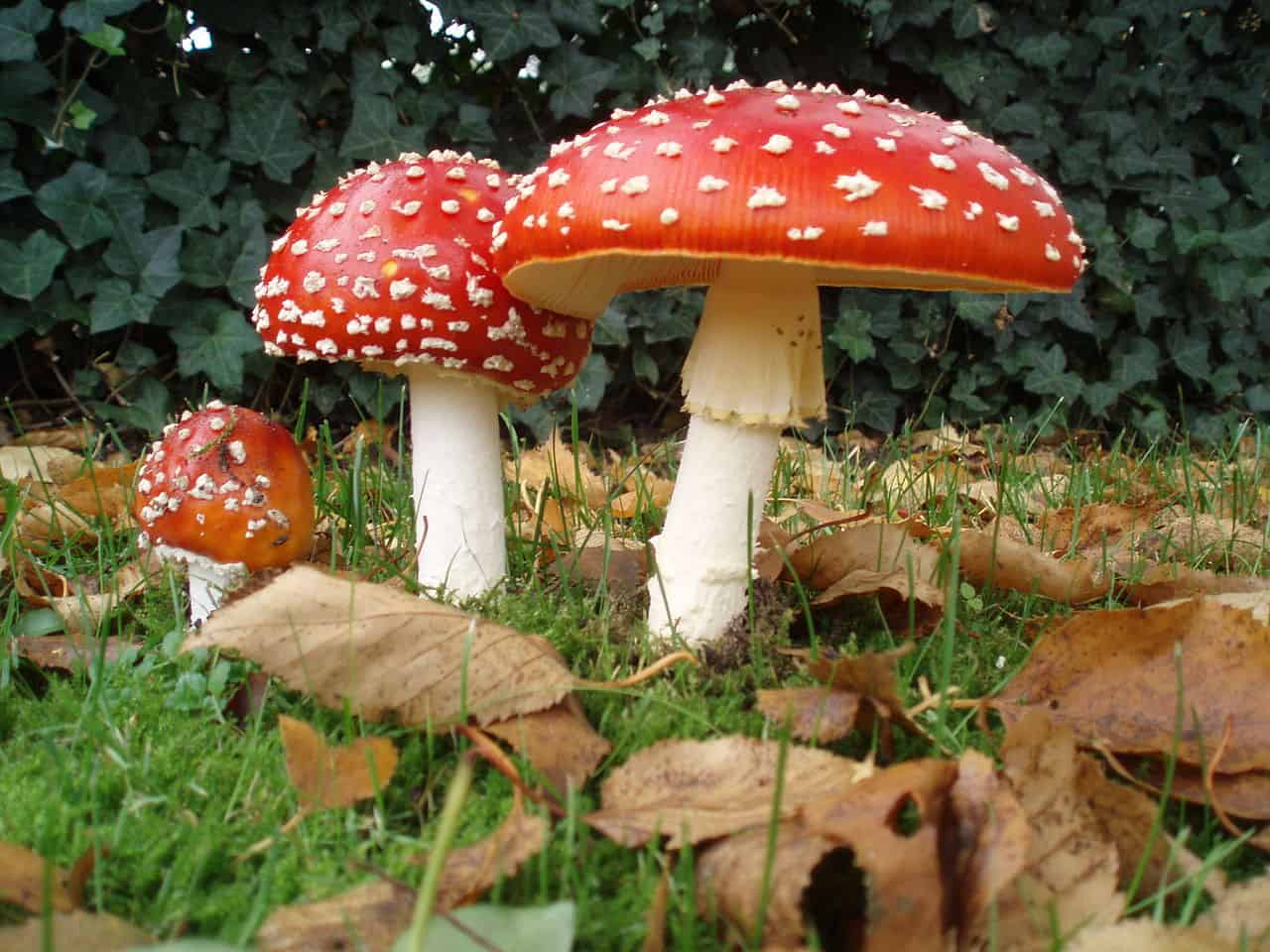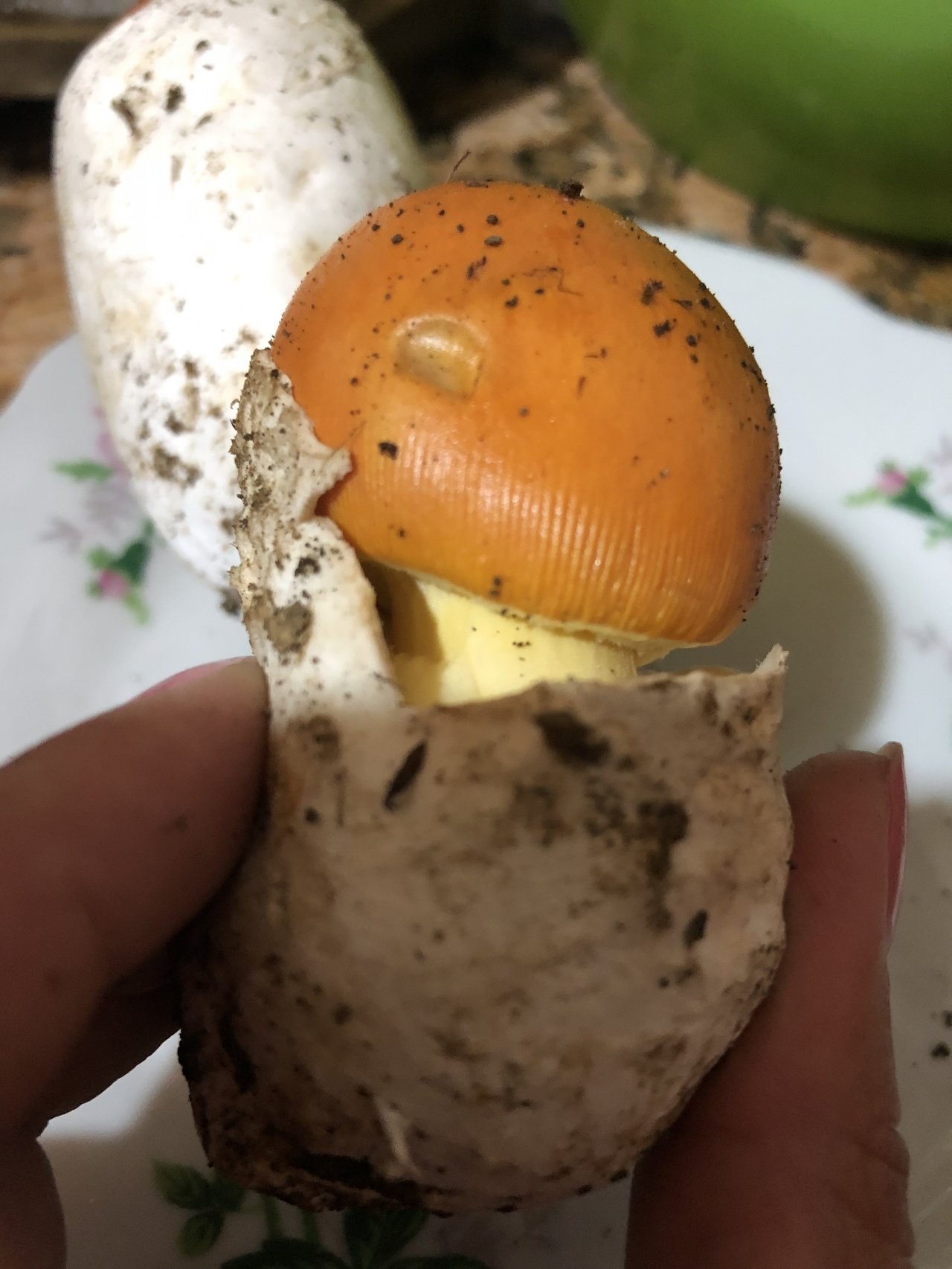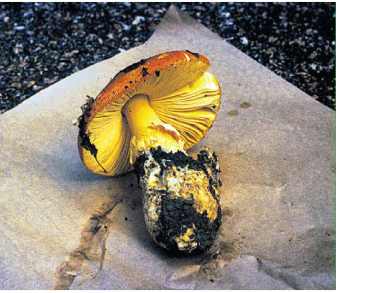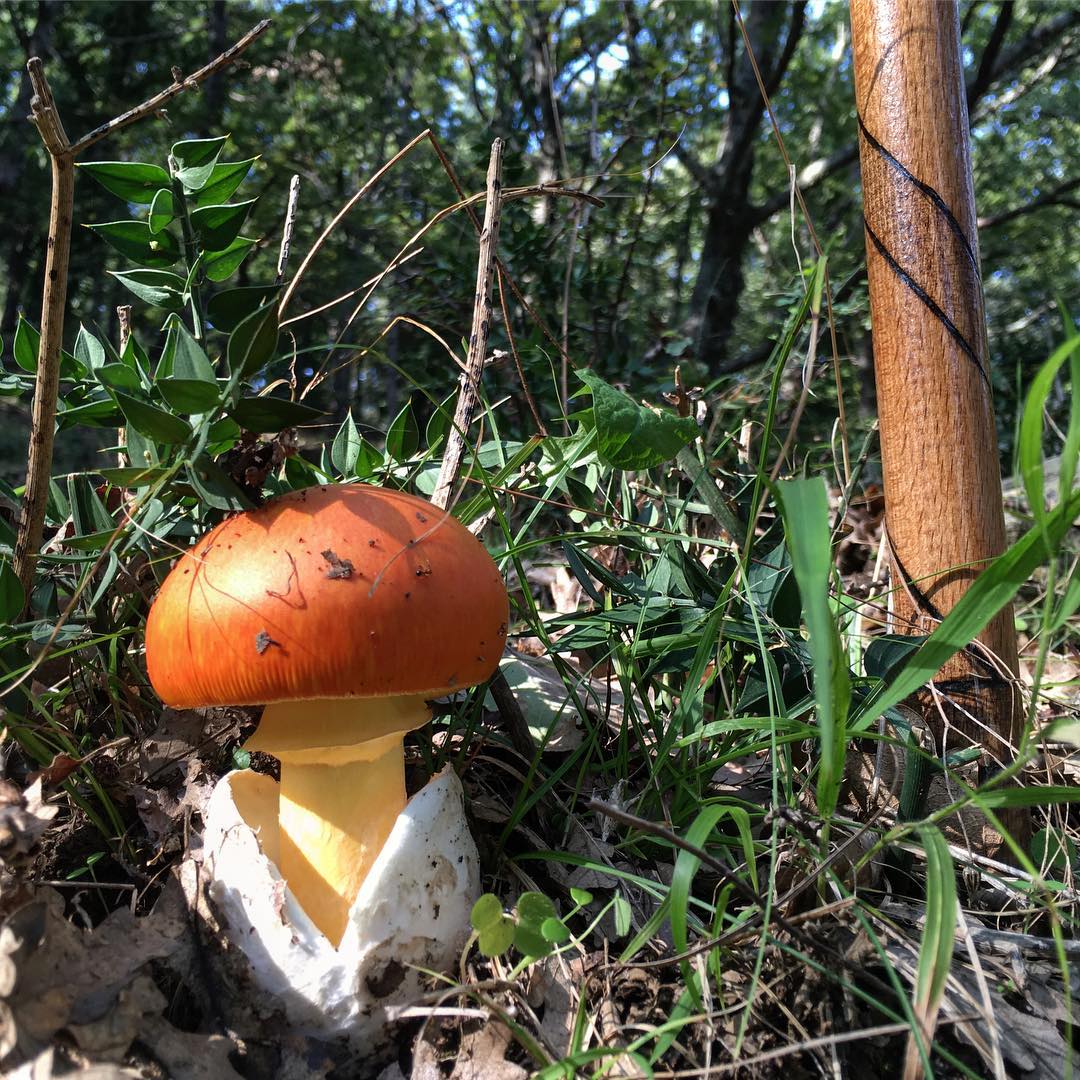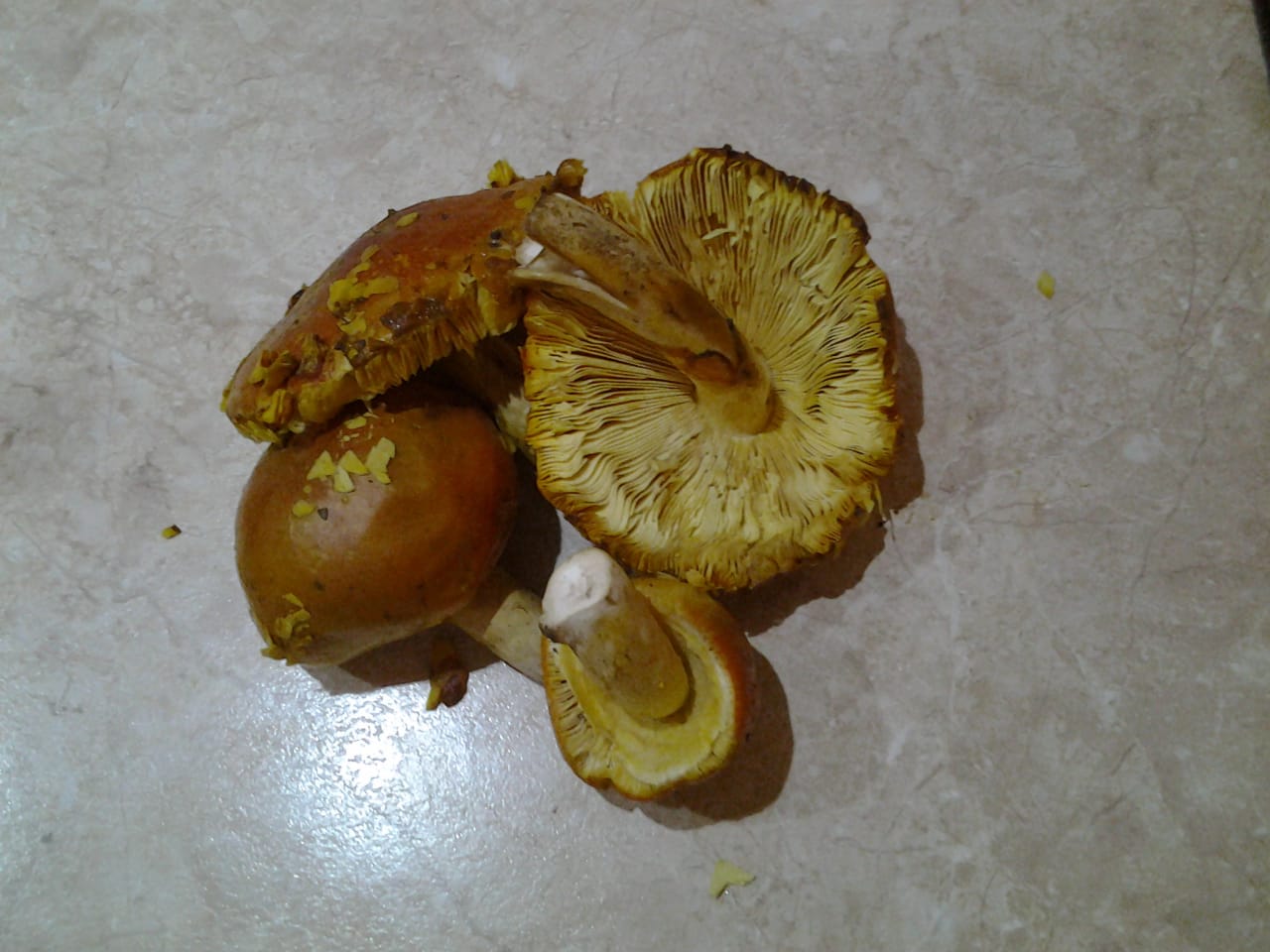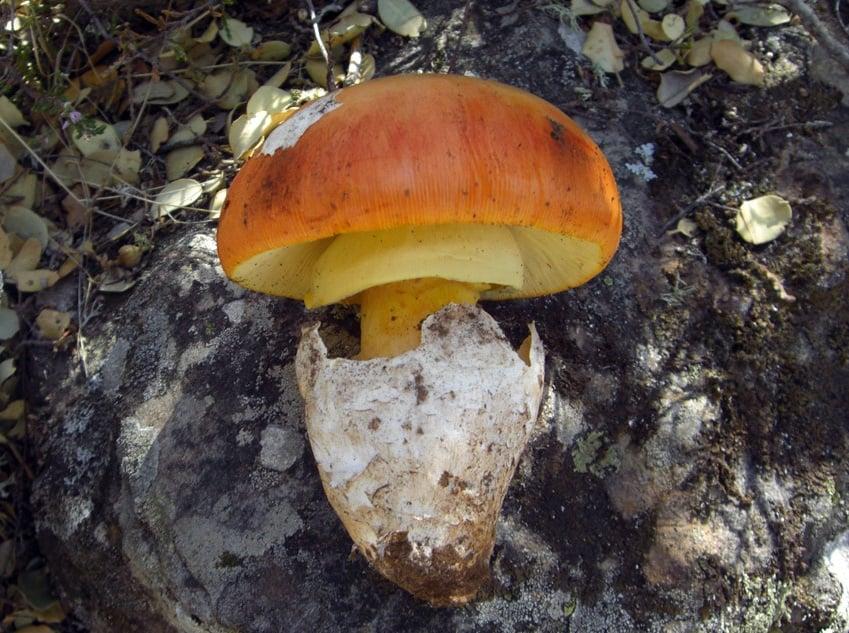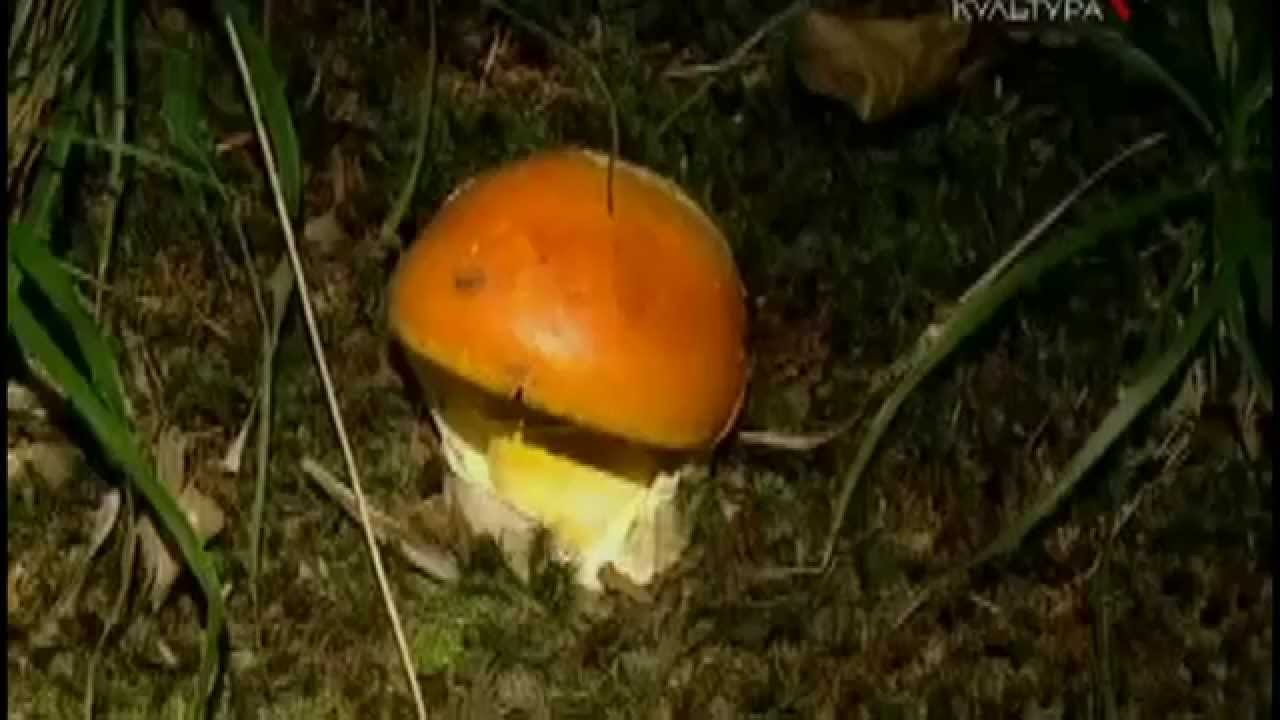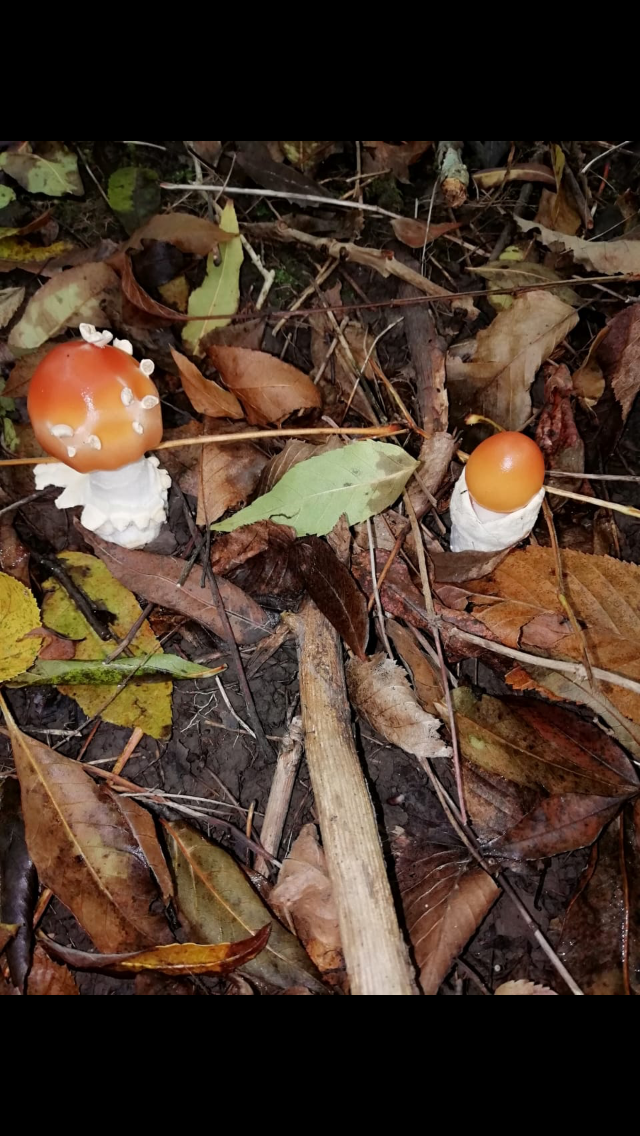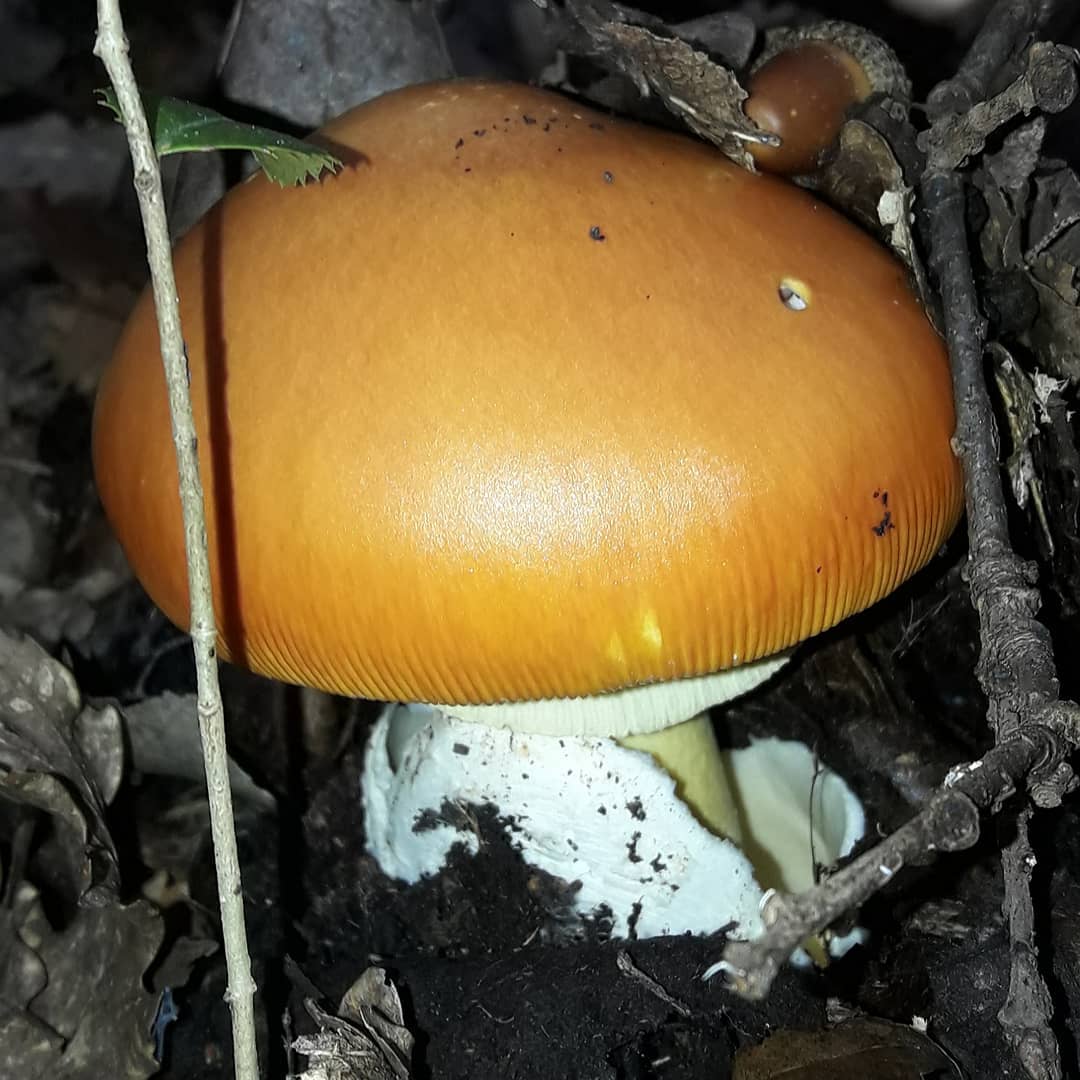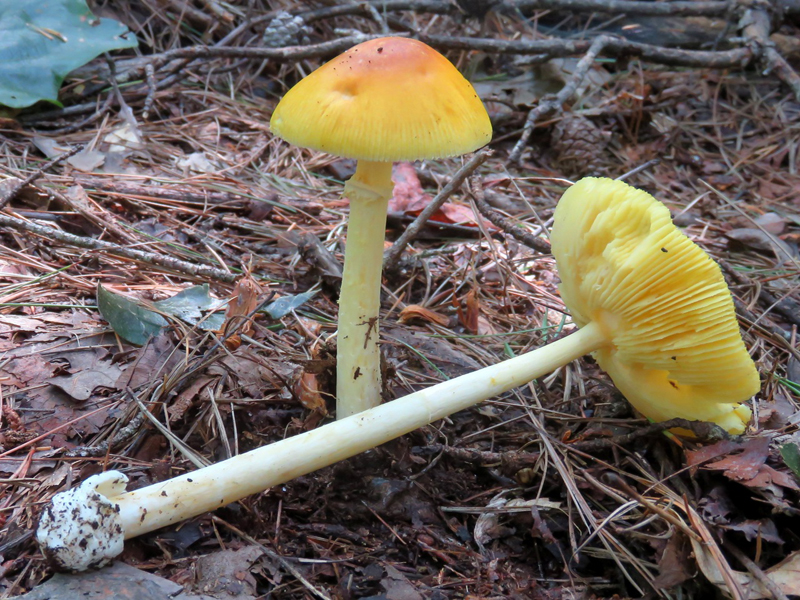Description
In order not to confuse it with a poisonous one, you need to know the features of the appearance of an unusual mushroom:
- the beginning of development occurs in a volva, which resembles a large egg. As it grows, the egg-shaped shell bursts and encircles the edible fly agaric;
- the vagina is usually white, loose or semi-free, leathery;
- the leg is strong, elastic, fleshy, has a clavate shape (tuberous base), reaches a height of 5-20 cm, its flesh is snow-white, the surface layer is yellow-orange;
- the cap is bright red or deep yellow, its color fades over time;
- the flesh of the cap is white, but yellowish along the periphery;
- the top of a young royal mushroom resembles a hemisphere, up to 20 cm in diameter.
Irina Selyutina (Biologist):
For the Caesar mushroom, forms are known that differ from the main species in the color of both the cap and other parts of the body. So, in China, a variety of white was discovered.
For the Far East, a Far Eastern Caesar mushroom is described, which was named Amanita caesareaoides. It differs from the common Caesar mushroom (Amanita caesaria) by a yellow volva inside and the presence of a special yellow cup inside it, reaching a height of 3 cm in large fruit bodies.In addition, there are characteristic differences for the caps of the Far Eastern Caesar mushroom:
- there is a tubercle in the center;
- there are no scraps of bedspread.
The Far Eastern Caesar mushroom is known in Primorye and on the territory of southern Sakhpalin (oak forests, hazel thickets, less often under birches).
Both common and Far Eastern Caesar mushrooms are edible.
Unlike the familiar to us red fly agaric, the cap of which is "supplied" with white specks, the remains of the veil disappear very quickly in the Caesar mushroom.
Caesarean mushroom (royal mushroom, Caesar's fly agaric) - benefit
Like all mushrooms, the cesarean mushroom has a huge supply of trace elements and minerals such as calcium, phosphorus, fat-soluble vitamins A and D, nicotinic acid, PP vitamins, ascorbic acid, B vitamins. The Caesar mushroom has a record high protein content. Despite its entire chemical composition, Caesar's amanita is a low-calorie product, well absorbed by the body, does not cause heaviness in the stomach. The king's mushroom is consumed both raw and after heat treatment. The pulp of the mushroom has a very delicate delicate taste and pleasant aroma. Culinary gurus from all over the world create their own masterpieces, including the Caesar mushroom in the dishes.
Caesar mushroom is a type of mushroom that is used in pharmacology. Microbiologists from the USA and Japan have found that enzymes contained in Caesar mushrooms have a preventive effect against cancerous tumors. Caesar mushroom (royal mushroom) is an important food for men, as the components of the mushroom reduce the risk of prostate diseases.
At the same time, Italian scientists found out that the royal mushroom accumulates heavy metals such as cadmium, mercury, arsenic, lead, and selenium.
| Caesar mushroom |
|---|
| Scientific classification |
| Domain: | Eukaryotes |
| Kingdom: | Mushrooms |
| Subkingdom: | Higher mushrooms |
| Department: | Basidiomycetes |
| Subdivision: | Agaricomycotina |
| Class: | Agaricomycetes |
| Subclass: | Agaricomyceteaceous |
| Order: | Agaric |
| Family: | Fly agaric |
| Subgenus: | Amanita |
| Section: | Caesarea |
| View: | Caesar mushroom |
International scientific name
- Agaricus caesareus Scop., 1772 basionym
- Volvoamanita caesarea (Scop.) Beck, 1922
- Venenarius caesareus (Scop.) Murrill, 1913
- Amanita aurantiaca Gray, 1821 and others.
Caesar mushroom (lat.Amanita caesarea) - an edible mushroom of the Amanite family (AmanitaceaeThe Russian name, like the Latin specific name, comes from the title of the rulers of the Roman Empire. Sometimes he is associated specifically with Guy Julius Caesar.
Caesarean mushroom, Caesarean fly agaric, Caesarean fly agaric, royal mushroom.
Description
The fruiting body is typical captiperal, with a central peduncle.
The cap is 8-20 cm, ovoid or hemispherical, later from convex to flat, with a grooved edge. The skin is golden-orange or bright red, dry. The remains of the bedspread on the skin are usually absent.
The flesh of the cap is fleshy, light yellow under the skin; legs - pure white in section; without characteristic smell and taste.
Leg 8-12 in height, 2-3 cm in diameter, with a tuberous base, yellow-orange, smooth, slightly striped above the ring.
The plates are golden yellow, free, frequent, wide in the middle, slightly fringed edges.
The remains of the bedspread: the ring is descending, wide, grooved, the color is like that of the leg; volva is loose, bag-shaped, reaches a width of 6 cm, a thickness of up to 4-5 mm, white outside, the inner surface may be yellowish or with an orange tint.
The spore powder is whitish, the spores are broadly ellipsoidal, 8-12 × 6-7 microns, non-amyloid. Basidia are tetrasporous, 40–45 × 8–10 µm, clavate, thin-walled, colorless.
Variability
The shade of the cap changes from more yellow to more red. Rarely on the cap there are particles of the bedspread in the form of large flat scales. An overripe mushroom smells like hydrogen sulfide.
Sometimes very pale to almost white specimens are found that have been described as a form of A. Caesaria f. alba (Gillet) E.J. Gilbert, however, are always found next to normally colored fungi, and the existence of an independent form is disputed.
Ecology and distribution
Mycorrhizal forming agent with beech, oak, chestnut and other hard tree species. Grows on soil in deciduous, occasionally coniferous forests, prefers sandy soils, dry places. It grows in groups under fallen leaves, in the form of an egg under the ground. Fruiting only on the southern slopes of the mountains on the edges, glades and clearings due to extreme heat-loving. It has been established that for fruiting this mushroom needs stable warm weather (not lower than 20 ° C) for 15-20 days. Giacomo Bresadola (1927) noted that the area of the Caesar mushroom in the Mediterranean and adjacent regions almost coincides with the area of distribution of viticulture.
Distributed in warm regions of the northern temperate climate, in the Mediterranean subtropics. In the countries of the former USSR, it is found in the western regions of Georgia, in Azerbaijan, in the North Caucasus. Finds of it are known in the Crimea (oak groves on the northern slope of the Yalta yayla) and in Transcarpathia. Grows in the south of the Russian Far East. (In the Primorsky Territory).
Storage methods
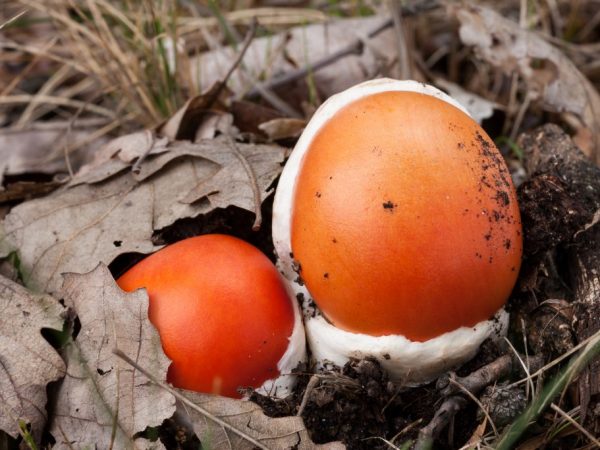
Young mushrooms are suitable for cooking
Like any other mushrooms, "royal" fly agarics are stored in several ways:
refrigerator: it is important that the mushrooms do not come into contact with each other. To do this, each of them must be wrapped in a damp soft natural cloth, and then placed in a common paper bag
The shelf life of such mushrooms is 3-5 days;
drying: stored in glass or plastic jars with sealed lids. This method helps to maintain the beneficial properties of fly agarics for 6-12 months;
freezing: they are pre-boiled until cooked, then they are laid out in portions in separate containers and placed in the freezer. The shelf life is no more than 4 months.
Amanita Caesar and pale toadstool: differences
Be careful not to confuse the caesar mushroom with the pale toadstool. The fact is that in the egg stage, they can be similar. What is the difference between these mushrooms?
Firstly, the cap of the royal mushroom is reddish-orange, while the cap of the pale toadstool is white or green. Below, you can see the growth stages of a pale toadstool.
Pale toadstool - a poisonous mushroom
- Secondly, in the "egg" stage, the pale grebe and the royal fly agaric differ when cut.
- The edible caesarean mushroom has a yellow cap (see photo below), and the pale toadstool has a white cap.
On the left, a venomous pale toadstool in a section, on the right, Caesar's edible fly agaric
Recipes
There are a lot of dishes from Amanita Caesar. For cooking, it is better to use young specimens that have just emerged from the "egg" shell. They contain the maximum amount of nutrients and nutrients, which decreases as the fungus grows.
With cheese
To prepare this dish, it is recommended to use suluguni cheese, which will give it a special piquancy.
You will need the following ingredients:
- Amanita Caesar - 0.5 kg;
- butter (softened) - 60 g;
- suluguni cheese - 150 g;
- black pepper to taste.
This dish will not take long to prepare.
- Preheat the oven to 200 ° C.
- We clean the mushrooms, wash, prepare for baking: carefully separate the legs from the caps, cut large specimens into several parts.
- On a baking sheet covered with oiled parchment paper or cooking foil, lay out the prepared mushrooms in one layer and send them to the oven for 10 minutes.
- Grind suluguni on a coarse grater and mix with butter.
- After the allotted time, take out the mushrooms, pepper and evenly spread the cheese-butter mass on them.
- Place the baking sheet in the oven for another 5 minutes.
- When serving, the dish is generously sprinkled with herbs: cilantro, parsley, dill, etc.
If you think that suluguni is not enough for you, then add some salt to the dish.
With bacon
A very interesting combination is obtained by combining mushrooms with crispy bacon strips. The composition is complemented by a barely perceptible smell of garlic, which makes the dish even more piquant and stimulates the appetite with its delicate aroma.
For cooking you will need:
- "Caesar mushrooms" - 500 g;
- onion - 1 pc.;
- hard cheese - 150 g;
- vegetable refined oil - 2 tbsp. l .;
- heavy cream (or sour cream) - 2 tbsp. l .;
- egg - 1 pc.;
- garlic - 1 clove;
- slices of bacon.
This delicious dish is prepared in several stages.
- Wash the mushrooms and dry them on a paper towel. Gently unscrew the leg from each. To increase the space for the filling, remove some of the membranes on the cap with a spoon.
- Pour vegetable oil into a frying pan and place it over medium heat.
- Cut the onion into small cubes and pour into the pan.
- Chop the legs and place them in a container together with the crushed clove of garlic.
- After 5 minutes, add cream (sour cream) to the pan, salt and pepper to taste and, without covering, simmer until tender.
- Finely grate the cheese, beat the egg well with a pinch of salt.
- Preheat the oven to 180 ° C, cover the baking sheet with parchment paper, grease well with melted butter.
- Put 1 tsp in each hat. fillings and pour in 1 tsp. beaten egg. Smooth out the surface with a spoon and sprinkle with a small amount of grated cheese.
- We put each hat filled with filling in the middle of a strip of bacon, with the ends of which we cover the mushroom. For reliability, the edges of the bacon slice are secured with toothpicks.
- The baking sheet is placed in the oven for 15-20 minutes.
- The dish is served hot, sprinkled with herbs, with a vegetable salad or other side dish.
Fruit and mushroom salad
Fans of dishes with an unusual taste will love the combination of mushrooms and fruits. This salad is not only tasty, but also healthy. To prepare it, you need the following ingredients:
- young "royal mushrooms" - 200 g;
- sweet apples - 2 pcs.;
- hard cheese - 200 g;
- tangerines - 2 pcs.;
- red bell pepper - 1 pc.
Cooking description:
- we clean the mushrooms, wash, boil until tender and cool;
- cut apples and cheese into medium-sized cubes, bell pepper - half rings;
- we clean tangerines from partitions (remove a white film from each slice), chop coarsely;
- Mix all the ingredients and season with the sauce. To prepare it, you need to take 1 tsp. French mustard and apple syrup and mix with 1-2 tbsp. l. olive or refined vegetable oil;
- salt and pepper the salad as desired.
The medicinal properties, excellent taste and benefits of Caesar mushrooms make them a desirable prey for lovers of "quiet hunting". Before placing a mushroom resembling an amanita in a basket, carefully examine it.
Growing methods
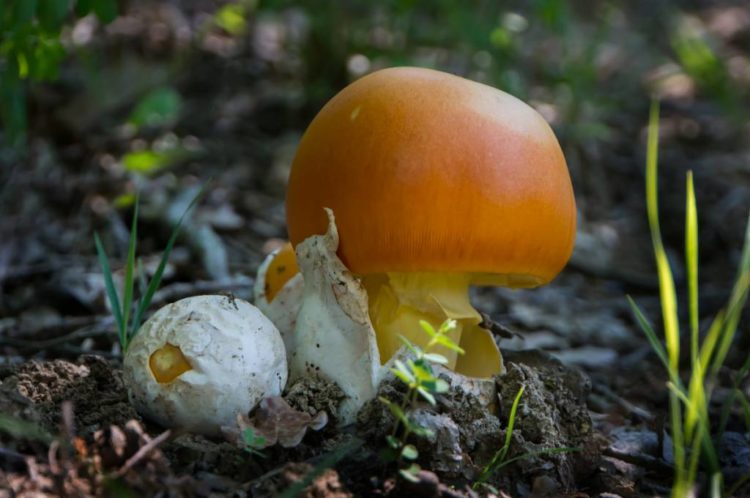
According to the description, the Caesar mushroom does not belong to those fertile bodies that are popular among those who like to grow mushrooms in their summer cottage, since the conditions for this should be close to those in which it grows in the forests. In addition, it takes more than one year to wait until Caesar's fly agaric grows. For the right environment, you need to have trees such as chestnuts, birches, oaks on the site, with mushrooms associated with their roots.
There are several ways to grow it. A sign that the planting has taken root is the white mycelium filaments at the planting site. It is better to use old mushrooms for planting.
Landing action plan:
- Bury the ground fly agarics under the roots of the trees, but not deeply.
- Scatter pieces of mushrooms near the desired trees, cover with foliage and water regularly with warm water.
- Transplant fly agarics from the forest.
- Prepare planting material. To do this, the mushrooms are crumbled into a bucket, filled with rainwater, after which the bucket is kept at a temperature slightly above 20 ° C for 2 days. Then the contents of the bucket are poured into a landing site that meets the required conditions.
Video
Sources of
Description of the Caesar (royal, egg) mushroom
The fruiting body of the cap is pedunculated, the stem is located in the center. The diameter of the cap ranges from 8 to 20 centimeters. The shape of the cap is hemispherical or ovoid, over time it becomes convex, and then completely flat. The edges of the cap are grooved. The skin of the cap is orange-golden or bright red. As a rule, there is no remaining blanket.
The flesh of the cap is fleshy, light yellow in color. The flesh of the leg is completely white, without the characteristic taste and smell. The height of the leg ranges from 8 to 12 centimeters, and its diameter is 2-3 centimeters. The base of the stem is tuberous. The color of the leg is yellow-orange, the surface is smooth, slightly striped above the ring.
The plates are loose, wide, often located, golden-yellow in color, their edges are slightly fringed. The ring is descending, wide. The color of the ring and the leg is the same.

Volvo is free, 6 centimeters wide, white on the outside, and may be yellowish on the inside. Elliptical spores. The spore powder is whitish. Basidia are clavate, colorless, with thin walls.
Variability of the royal mushroom
The shade of the caesar mushroom cap varies from red to yellow. In rare cases, there may be particles of the coverlet on the cap that look like flat scales. Overripe specimens develop the smell of hydrogen sulfide.
Sometimes there are Caesar mushrooms with a very pale color, almost cep, which have been described as a separate form of A. Caesaria f. Alba, but they always grow alongside normal forms.

Distribution of cesarean mushroom
Caesar mushrooms form mycorrhiza with oak, beech, chestnut and other hard tree species. These mushrooms grow in deciduous and coniferous forests, preferring sandy soils.
Caesar mushrooms choose dry and warm places. They are common in warm temperate regions and subtropics. The royal mushroom grows in the Crimea, the North Caucasus, Georgia, Azerbaijan and Transcarpathia.
It was found that in order for Caesar's fly agaric to bear fruit, the weather should be warm - the temperature should not drop below 20 degrees for 15-20 days. In the Mediterranean, the growing areas of Caesar mushrooms coincide with the vineyards. The fruiting season is from summer to autumn.

Similar species
Caesarean mushroom bears similarities to a poisonous mushroom - a red fly agaric. It is a psychoactive mushroom belonging to the Basidiomycetes family. The red fly agaric was used as an intoxicating substance in Siberia and had religious significance among the local population.
The red mushroom can be distinguished from the Caesar mushroom by the following features:
- The cap of the royal mushroom is smooth, usually there are no remnants of the veil on it, and in the red fly agaric it is covered with white warts;
- The color of the plates in the Caesar mushroom is golden yellow, and in the red fly agaric they are white;
- The volva of the cesarean mushroom is wide, bag-shaped, free, and adherent in the red fly agaric, looks like ring-shaped remains at the base of the leg.

Young Caesar mushrooms can be confused with deadly poisonous pale toadstools. But Caesar's fly agaric differs from the pale toadstool on the cut in the yellow skin of the cap.
The appearance of the mushroom
This mushroom belongs to the Amanita family - Amanita caesarea. It is edible, belongs to the category of special delicacies, popular even at the feasts of the nobility in the Roman Empire. It is also called Cesarean fly agaric, royal mushroom, royal fly agaric, and Caesar fly agaric.
In appearance, this fruiting body resembles a typical red fly agaric, especially after rain, when characteristic white flakes are washed off the cap of a poisonous fly agaric. The difference between them can be seen in the color of the leg. In the poisonous one, it is white, and in the royal mushroom it is yellow, white, it has only a Volvo, reminiscent of a broken eggshell.
The color of the cap is both bright red and orange-golden. If the mushroom is already old, then the color of its cap fades. At first it has a hemispherical shape, then it flattens out and becomes slightly convex. The hymenophore is lamellar, yellow or orange.
He begins to develop inside the same white egg-shaped shell, which subsequently encircles his leg. It grows to a fairly large size, and the cap has a diameter of up to 20 cm. The club-shaped leg of this mushroom is fleshy and strong, ranging in size from 5 to 20 cm in height and from 1.5 to 5 cm in diameter. Its flesh is white, but its surface layer is yellowish-orange.
Growing places
Caesarean mushroom grows in many countries, the climate of which is diverse. You can meet him both in the deciduous forests of Transcarpathia and Crimea, and in Africa. They meet him in the Caucasus and America, in such European countries as France, Italy, Germany and Spain. To a greater extent, it is classified as a thermophilic mushroom, since it is common in temperate regions and in the Mediterranean subtropics. The fact that the royal mushroom is a valuable organism is proved by its inclusion in the Red Data Books of Ukraine and Germany.
The Caesar mushroom is confused with such an organism as the similarly edible Far Eastern Caesar mushroom (Amanita caesareoides). This is not surprising, since they are not just doubles, but belong to the same family - the Amanite. The Far Eastern counterpart looks the same, it differs only in the name, and in the fact that it is common in the deciduous forests of the Far East.
Harm and contraindications to the use of Caesar mushroom

Despite the voluminous list of useful properties, only a limited amount of Caesar mushroom can be eaten. Its frequent and uncontrolled activation can negatively affect the state of health and cause serious malfunctions.
The consequences of abuse of the Caesar mushroom:
- The manifestation of an allergic reaction - there are redness and irritation on the skin, dizziness, fainting, indigestion, flatulence, stool disturbances, nausea, vomiting, the sclera of the eyes turn yellow, apathy appears, blood pressure drops, vital energy disappears, mucous membranes become covered with abscesses.
- In women, the menstrual cycle may malfunction - severe pain in the lower abdomen, headaches, there is a high risk of developing endocrine disorders.
- Frequent urination - the bladder becomes toned, excessive irritability appears, sleep patterns are disturbed, calcium is washed out of the bones.
- Inflammation of the liver and kidneys - the mucous membranes are susceptible to negative effects, the development of glomerular nephritis is possible.
The Caesar mushroom must be collected away from highways, as it, like a sponge, absorbs pathogenic microflora and toxins through the ground. Also, they should not be abused for epilepsy, since there is a risk of provoking an attack.
Cooking steps
Pour water into the multicooker bowl, add sugar, stir. Set the "Extinguishing" program for 20 minutes.Stir occasionally and boil the syrup.
Peel the apples and then remove the seeds.
Cut the apples into small pieces or cubes. The weight of the sliced apples should be 1 kilogram.
Arrange the finished jam in sterilized jars, tighten with boiled lids.
Delicious and fragrant apple jam, cooked in a multicooker, is perfectly stored at room temperature all winter. When the jam cools, it will become thicker.
Servings: 2-3
Difficulty: 3
out of 5
Blanks for the winter are a storehouse of good mood in the cold season. Having opened a jar of jam, jam, jam made from aromatic strawberries, juicy pears or summer apples, we let a piece of summer into our home.
Rolling up jars of sugar fruits or berries is a good tradition that allows you to meet winter with a supply of sweets.
Each housewife has her own favorite recipe, which has been used for more than one generation. But time makes its own adjustments, including in the preparation of blanks.
Today, you can cook delicious jam or jam much faster and without much hassle if you adopt recipes for a multicooker. So, our guest today: apple jam in a slow cooker.
It is also used to fill sand baskets and grease the top of the cakes before coating with chocolate icing.
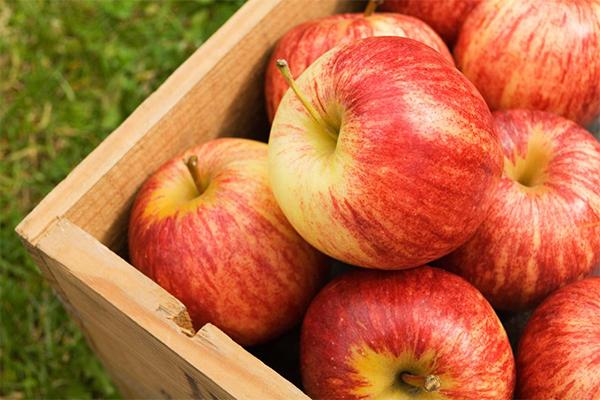
Well, if baking is not your passion, then you will still like the recipe, because there is nothing tastier than a piece of fresh bun, buttered and covered with a thin layer of sweet apple jam.
The color and consistency of conservation is influenced by the variety of fruits used. You can make jam from any apples, but it is best to choose varieties such as Antonovka, White filling, Granny Smith, Semerenko.
Why so much fuss with the peel? Almost all recipes insist that the peel be removed from the fruit, regardless of the variety. And although the peel of Antonovka or apples of the white filling variety does not differ as hard as, for example, the granny Smith peel, it is better to cut it off, since it is very likely that otherwise pieces of the peel will fall into the thickness of the jam.
But instead of sending the cleanings to the trash can, it is better to boil them. The apple peel contains an abundance of pectin - a gelling agent, with the help of which the jam will acquire its dense consistency.
The second recipe is simpler: you can not cut off the peel, do not fool your head by preparing the broth. Cooking a treat for the winter should be done in two steps, but the technology is completely simple.
Therefore, if you are not in the mood to experiment or prefer simpler cooking methods, it is better to go straight to the second part.
Pour water into the multicooker bowl, add sugar, stir. Set the "Extinguishing" program for 20 minutes. Stir occasionally and boil the syrup.
 Peel the apples and then remove the seeds.
Peel the apples and then remove the seeds.
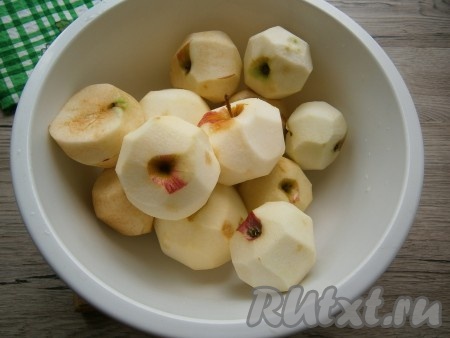 Cut apples into small pieces or cubes. The weight of the sliced apples should be 1 kilogram.
Cut apples into small pieces or cubes. The weight of the sliced apples should be 1 kilogram.
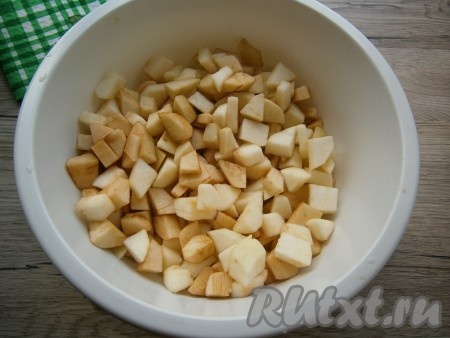 Pour the apples into the syrup, add citric acid, mix.
Pour the apples into the syrup, add citric acid, mix.
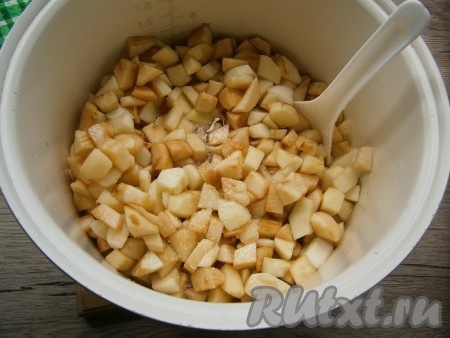 Set the multicooker program “Stewing” again for 20 minutes, close the lid of the multicooker, then switch to the “Baking” mode for 10 minutes. After that, add vanillin to the apple jam, mix and turn on the "Stew" mode again for 15 minutes. Periodically, during the last stewing, the jam needs to be mixed.
Set the multicooker program “Stewing” again for 20 minutes, close the lid of the multicooker, then switch to the “Baking” mode for 10 minutes. After that, add vanillin to the apple jam, mix and turn on the "Stew" mode again for 15 minutes. Periodically, during the last stewing, the jam needs to be mixed.
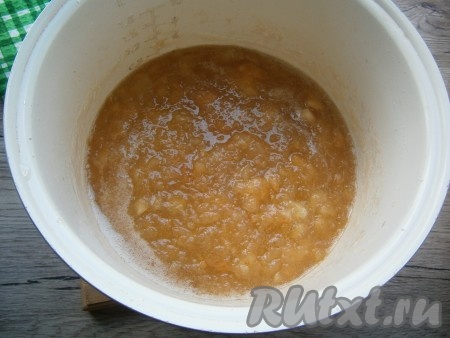 Arrange the finished jam in sterilized jars, tighten with boiled lids.
Arrange the finished jam in sterilized jars, tighten with boiled lids.
 Turn the jars and wrap them well until they cool completely.
Turn the jars and wrap them well until they cool completely.
 Delicious and fragrant apple jam, cooked in a multicooker, is perfectly stored at room temperature all winter. When the jam cools, it will become thicker.
Delicious and fragrant apple jam, cooked in a multicooker, is perfectly stored at room temperature all winter. When the jam cools, it will become thicker.

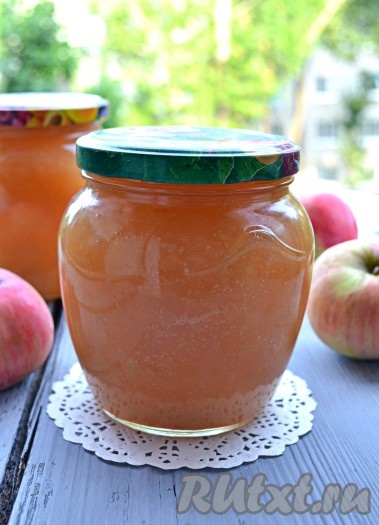 Bon Appetit!
Bon Appetit!

